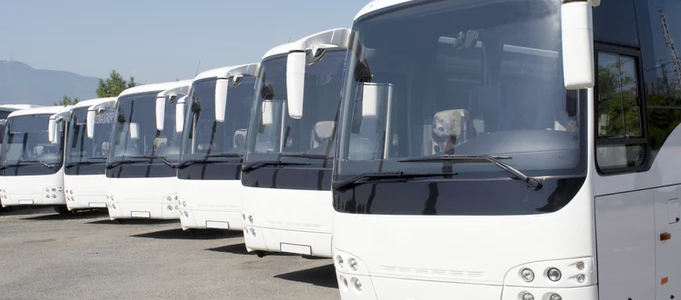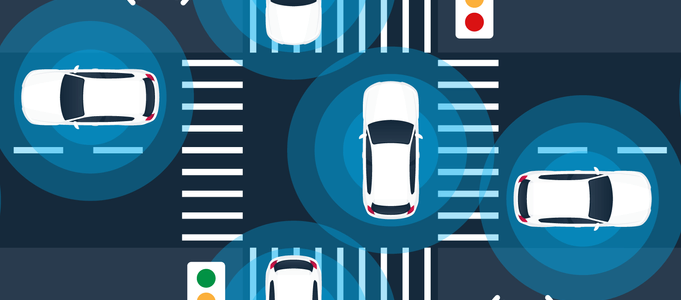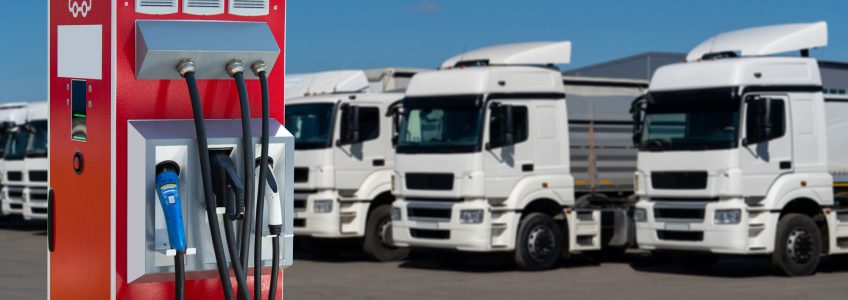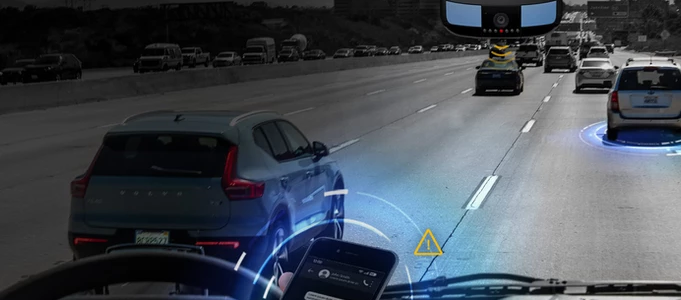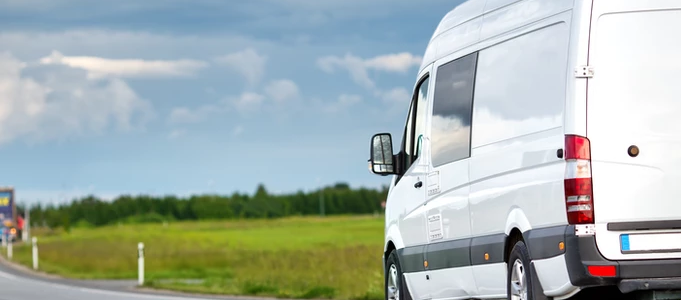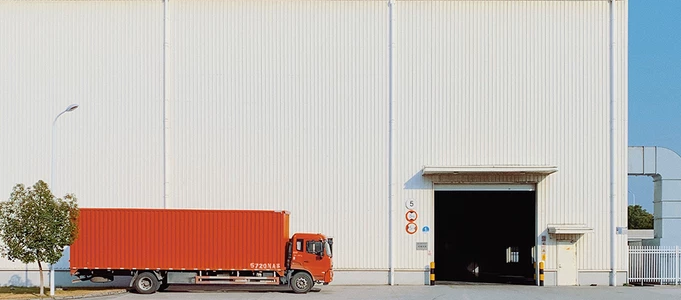The Latest on Heavy-Duty Fleet Electrification (Part 2)
We have been posting a number of blogs on the electrification of fleets across industries with an emphasis on the heavy-duty fleet sector. Without a doubt, the electrification in transportation is an inevitability and with reason: not only does it lead to technological advances that increase efficiency but it also offers an essential response to environmental and sustainability concerns.
We covered both the barriers and benefits of the electrification of heavy-duty fleets in our last blog post (link to Blog Post C). Now we turn our attention to the implications of adding electric models to heavy diesel industries, among other updates on the advancement of heavy-duty fleet electrification.
Air Quality and Health
Much of the air pollution in lower-income communities comes from the diesel trucks that move products to and from nearby industrial areas. Diesel emissions are also a major source of nitrogen dioxide which prevents these areas from achieving air quality levels necessary for good public health. The state of California estimates that their new electric truck mandate could prevent 900 premature deaths in these communities and deliver $9 million in public health benefits.
Impact to Grid
Electrification of the heavy-duty sector presents unique challenges and opportunities compared to light-duty EVs. With considerably larger batteries and higher charging rates, if left unmanaged, charging heavy-duty vehicles could have negative impacts on the grid. However, implementing smart charging systems can reduce these impacts. Mechanisms such as off-peak electricity demand charging, dynamic controlled charging and vehicle-to-grid (V2G) could all help to mitigate the impact of electric trucks (eTrucks) and electric buses (eBuses) on peak demand and reduce electricity generation capacity needs.
Oil Demand and GHG Emissions
Even though trucks represent less than 5% of the global vehicle stock, their high fuel consumption and mileage means that they are responsible for over a third of global diesel demand and 3% of total global energy demand. The electrification of these trucks would therefore have a significant impact on overall diesel and oil demand. Across all vehicle weights, it is estimated that EVs will displace 4.3 million barrels of oil per day by 2030. GHG emissions are closely related to fuel consumption, and medium- and heavy-duty trucks are responsible for a sizable share of total GHG emissions. As diesel drivetrains give way to electric, the resulting fall in GHG emissions will be considerable.
Government interventions to accelerate the transition of heavy-duty transport to electric
California is the first state to approve specific legislation to accelerate a large-scale transition of zero-emission medium- and heavy-duty vehicles. The Advanced Clean Trucks (ACT) Regulation was passed by the California Air Resources Board to help the state meet its mandates to reduce air pollutants, in order to protect public health and meet climate change targets.
The regulation requires that manufacturers who certify Class 2b-8 chassis or complete vehicles with combustion engines would be required to sell zero-emission trucks as an increasing percentage of their annual California sales from 2024 to 2035.
Seven other states and the District of Columbia have signed a statement of intent to pursue a similar medium- and heavy-duty zero emission vehicle initiative.
The importance of varied EV model support for complete fleet management
As fleet and sustainability managers make their long-term plans for fleet electrification, it’s vital to select a fleet management platform that can support the greatest range of makes / models, and that has the capabilities to accommodate the most new EVs as they come to market.
Geotab has been independently ranked as the number one commercial telematics vendor for two years running. And with support for over 100 electric vehicles, it’s the strongest telematics provider in the EV space.
It’s likely that managers will initially have to operate a fleet consisting of both electric and conventional vehicles. The fleet management platform must therefore be able to work with all drivetrains, so that performance data such as mpg and mpg-e can be directly compared. The platform also needs to be able to collect electric-only data such as battery state of charge, to ensure optimal performance and maximum ROI during the transition to an all-electric fleet.
Our Geotab fleet management platform offers the widest make / model support of all EVs, from light- to heavy-duty, to support your fleet today and into tomorrow.
(Article source: https://www.geotab.com/white-paper/heavy-duty-fleet-electrification-trends/)
The Latest on Heavy-Duty Fleet Electrification (Part 1)
In a recent blog post we talked about the five electric commercial truck companies we are watching in 2021. Today we will go deeper into the latest trends we are seeing in the heavy-duty fleet category. Although this segment of the commercial vehicle market is still young, the world’s largest manufacturers have made it clear that they see electrification as an increasingly important piece of the freight transportation industry.
Just in the past few years, we have started to see an increase in market share of electric trucks (eTrucks) and electric buses (eBuses). Most of the major Original Equipment Manufacturers (OEMs) and several start-ups are preparing to launch their respective battery electric or fuel-cell/battery models in 2021/22, and the electric bus market is already well established in the U.S. With the early adoption of EVs, fleet and sustainability managers can get ahead of stringent emission regulations, which will make it inevitable that transit agencies, school districts and logistics companies deploy cleaner fleets.
Barriers (and Benefits) to Electrification in the Heavy-duty Sector
With such new technology, naturally there will be challenges to adoption. We note the most obvious ones below. We also highlight some of the benefits to adopting electrification in the heavy-duty sector as these certainly will offset the barriers through further technological advances and challenges being addressed.
Range
One of the greatest challenges facing heavy-duty electric vehicles is range. Trucks are intended to haul heavy trailers and loads, which are demanding tasks that contribute to quick battery drain. Load weight is another consideration in the heavy-duty sector. The benefits of eTrucks will certainly depend on load weight as a factor, as it can potentially result in higher electricity consumption and shorter range capability. Load capacity claims from OEMs suggest that they will be capable of matching today’s load standards, but they will require real-world data to prove this out.
Charging times
In order to counter the issue of range, manufacturers currently have to use larger, or more, batteries. The larger the battery capacity, the longer it takes to charge. Most eTrucks will take well over two hours to fully recharge on the fastest available charging systems, and some vehicles will have to plug in overnight to fully recharge a drained battery.
Carrying capacity
For a given GCWR (gross combined weight rating), electric trucks can’t carry as large a payload as their diesel counterparts, because their tractor weighs significantly more. This can leave the trucks with a several thousand pound shortfall in carrying capacity. This results in logistics companies needing more eTrucks to do the same amount of work as their conventional alternatives.
Now let’s look at the benefits of an electrified heavy-duty sector:
Improved torque
A feature that’s unique to eTrucks is instant torque, or the ability to deliver peak torque at zero RPM. This enables electric trucks to tow and haul a large payload at much lower speeds than their conventional counterparts.
Reduced maintenance requirements
Although pure electric vehicles require some scheduled maintenance for their electrical systems, this is minimal compared to that required for their ICE counterparts. This is because a pure electric vehicle has far fewer moving parts than a combustion engine, and no oil or transmission fluids to replace. Brake systems also last longer than for conventional vehicles, thanks to their regenerative braking systems.
Environmental noise reduction
While rolling noise remains a constant when comparing electric heavy-duty vehicles with their ICE counterparts, the propulsion noise is considerably lower without a combustion engine. This makes the biggest impact when vehicles operate at low speeds, as they most frequently do in urban areas, where noise pollution is the greatest concern.
Reduced Total Cost of Ownership (TCO)
In the U.S. long haul market, McKinsey predicts that medium- and heavy-duty trucks will reach TCO parity with diesel in the early 2030s. In urban operations, light-duty trucks and eBuses will have achieved parity by 2025, and medium-duty trucks pre 2030.
In our next blog post, we will cover the implications of adding more electric models to heavy diesel industries and the importance of EV model supports for successful fleet management transitions.
Connected Cars: A World of Possibilities for Enhanced Vehicle Performance
All over the world, businesses, governments and individuals are equipping their vehicles with internet connection, while the top auto manufacturers are embedding telematics devices in their newest models, making these the most game-changing smart device in recent years.
A connected car is a vehicle that is equipped with mobile technology, and therefore “connected” via the internet. Telematics is also used to connect cars, by means of a small device that plugs into the vehicle, or through embedded technology. The telematics device acts as an Internet of Things (IoT) hub which sends vehicle data to a cloud service, where it can be processed and 5G will speed up connected car benefits.
Fifth Generation of Wireless Technology
The introduction of 5G promises to improve the speed and reliability of mobile internet connection. At its peak, 5G operates 100 times faster than 4G and has extremely low latency. This means 5G devices can download and send vast amounts of data in a fraction of the time it would take using 4G.
5G is expected to grow the market for the ever-increasing number of tools, whether smartphones or thermostats, that rely on stable internet connection. One such tool, a connected car, generates millions of data points each day, which can be transferred faster than ever using 5G. Real-time tracking will become even more accurate, improving solutions like Advanced Driver Assistance Systems which help drivers avoid collision hazards.
OEM Telematics
A trend is emerging among leading vehicle manufacturers — or Original Equipment Manufacturers (OEMs) — to embed telematics devices directly into new vehicle models. Embedded devices are capable of processing OEM-specific vehicle information and telematics data once the consumer has given consent to the manufacturer. This data can then be integrated with an online fleet management platform that standardizes the user experience, enabling owners of fleets with a variety of vehicle and connectivity types to see all vehicle information in one place.
Connected Vehicle Technology and Applications
Once vehicles are connected, rich GPS and on-board diagnostics (OBD) data can be processed and presented on an online fleet management platform. Fleet managers can use this information to make critical business decisions, measure the effectiveness of those decisions and benchmark performance against similar fleets.
Here are a few ways fleets can benefit from connected vehicle technology:
-
Productivity: Track factors that influence fleet productivity, such as idling time, driving time, customer visits or ignition locations.
-
Safety: Detect risky driving behavior such as harsh braking, speeding or sharp cornering. Set up driver coaching and advanced driver assistance, or install dash-cam solutions to gain visibility into on-road activity.
-
Maintenance: Access vehicle health data. Use a connected fleet management platform to set up predictive maintenance to minimize the risk of unexpected, and potentially dangerous, vehicle failure.
-
Sustainability: Get precise data on fuel usage and inefficient activities like idling. Fleets made up of EVs, or a mix of EVs and conventional vehicles, can monitor charge levels, range and battery degradation.
How connected vehicle technology is changing the fleet industry
Today’s capabilities, such as those offered by Advantage Asset Tracking, go far beyond providing location information. Connected fleet managers can easily view and monitor variables like driver behavior, fuel usage, harsh events and engine health. This information can be used to construct comprehensive plans for improving fleet safety, productivity, sustainability and more.
Get More Mileage Out of Your Government Fleet With Geotab Keyless
Many government agencies may currently have larger than needed fleets. This means they have more vehicles than needed resulting in massive underutilization and unnecessary increased costs associated with maintaining those assets.
In any organization, it is important to utilize all assets as efficiently and effectively as possible. This is sometimes difficult with motorpools. Here’s why:
-
TCO — The total cost of ownership becomes very high, especially when all vehicles are not being used in the same way and potentially sitting in parking lots not being used.
-
Key management — Organizations must plan manual and physical ways to coordinate key drop-off and pick-ups, which becomes increasingly difficult during times such as the COVID-19 pandemic.
-
Billing and paperwork — When motorpools are shared between different departments, it increases manual billings and paperwork which can become time consuming for everyone involved.
-
Sustainability — Fleets with excessive vehicles have a larger carbon footprint. This works against state, local, federal or provincial sustainability mandates for reducing the use of combustion engine vehicles or decreasing carbon emissions.
-
Increased costs — There is an increase in costs including annual maintenance and labor, such as having to jumpstart a vehicle with a dead battery because of underutilization.
What’s a solution? Introducing Geotab Keyless: a digital key solution to help maximize motorpool utilization, providing a seamless car sharing experience and reduction in costs. Below are a few benefits of using this digital key solution.
1. Geotab Keyless is a secured and keyless access
Geotab Keyless eliminates the need for physical keys and helps organizations ensure only authorized employees have access to vehicles.
2. Improved utilization and aid in rightsizing your fleet
Get complete fleet visibility to reduce, repurpose or redistribute assets to increase utilization. With more drivers sharing one car, you can grow carsharing without growing the number of vehicles. Plus, Keyless makes it easier to prioritize vehicles with the lowest miles to maximize usage.
3. Seamless car sharing operations
Geotab Keyless makes it easy to share vehicles between departments in a government agency. Additionally, you can digitize billings with integrated software to reduce overall paperwork.
4. Reduce costs and save time
No staff is needed to physically manage keys or replace lost keys which will lead to a reduction in costs and save time.
5. Meet sustainability goals
With all vehicles being properly utilized, agencies can work toward achieving their sustainability goals.
Integrating telematics with Geotab Keyless
For government agencies, having the power of a telematics platform alongside secured keyless technology provides fleets with a safer way to control and manage day-to-day operations.
Geotab Keyless supports all vehicles that have a keyfob including electric, hybrid, Light-Medium and Heavy-Duty vehicles. It is easy to install and users also have the flexibility to use the application with a mobile app or NFC tags along with the ability to operate a free-floating or centrally located motorpool operation.
Sign up for a demo
Whether you are new to motorpools, or want to rightsize your fleet, explore the solution first-hand and sign up here to learn more. For more information or additional inquiries about Geotab Keyless, please email info@advtracking.net
Five Electric Commercial Truck Companies We are Keeping an Eye on in 2021
A number of startups and automotive giants have been busily working to electrify delivery and distribution trucks in the coming years: all-electric heavy-duty big rigs, semi-trucks, box trucks, delivery vans and more. While the major obstacles facing the electrification of the automotive industry are ones of scale, price points, battery technology, and charging station accessibility, advancements expected over the next 10 years will lead to more electric vehicles driving alongside or even replacing the diesel- and gas-powered trucks and vans that America relies on to carry goods (and people) across the country.
Here are five major players we are keeping an eye on in 2021.
BYD
Unlike other companies looking to disrupt the long-haul trucking industry, BYD is eyeing the short-haul goods movement sector, primarily in America’s ports, rail yards and freight-handling facilities. In 2020, it rolled out more of its battery-electric trucks to customers across the United States.
BYD’s Class 8 Day Cab has a range of 125 miles and a top speed of 65 miles per hour. The truck’s battery packs can recharge in as little as two hours with a high-speed direct current system or about 14 hours with a standard 240-volt charging system.
The company’s trucking division says its medium- and heavy-duty electric trucks are making up an increasing part of the company’s U.S. operations.
Chanje
One company aiming to electrify the package delivery industry is a Los Angeles-based, Chinese-backed startup called Chanje.
The company’s nearly 30-foot long V8100 electric medium-duty panel van can carry a 3-ton payload. What’s more, the van’s lithium-ion battery pack holds enough charge for a 150-mile range. According to the company, that’s more than double the number of miles the majority of commercial delivery vans drive in a day.
Daimler Trucks
In 2018, German automaker Daimler, the largest truck maker in the world, announced its all-electric 18-wheeler: the Freightliner eCascadia.
The big rig has a 250-mile range and was designed for regional transportation and port service. Daimler’s other all-electric model, the Freightliner eM2 106, has a 230-mile range and is intended for more local distribution and deliveries. Both the eCascadia and eM2 are currently planned to enter series production in late 2021. The company also has an all-electric box truck (for urban deliveries) and a school bus in the pipeline.
Nikola Motors
Few are likely to be familiar with the Phoenix-based startup that got the naming rights to Tesla’s first name. However, over the past five years, Nikola Motor Co. has slowly but surely emerged as a pioneer in this space.
The company has created the Nikola Two and the Nikola Tre for both European and North American markets. Each semi-truck is available with hydrogen fuel cell electric capabilities and their anticipated ranges are between 250 and 750 miles.
Lion
While the medium and urban truck markets are already getting attention from multiple truck manufacturers and a few startups, in the uncrowded school bus market there are only Lion Electric, Blue Bird, IC Bus, a division of Navistar, and Thomas Built, the division of Daimler Trucks/Freightliner.
Lion Electric has been around since 2008 and currently has an annual capacity to produce 2,500 trucks and buses per year. In addition to school buses, Lion Electric manufactures medium box and urban trucks, and specialty trucks such as garbage haulers. The usage profile for these trucks usually involves lower mileage per day and periods of overnight storage, lending themselves to excellent opportunities for electrification. Amazon is onboard with the opportunity to buy 2,500 Lion urban trucks and to potentially own 20% of the company.
For those considering converting all or part of their fleets to EVs, Advantage Asset Tracking has your entire fleet solutions roadmap covered backed by the worlds leading telematics provider, Geotab.
Our knowledgeable team will guide you through the entire selection process to ensure you make the right choice for your business!
Geotab announces release of upgraded GO9+ telematics device
GO9+ adds high-speed wireless to its flagship telematics solution to support fleet operations and burgeoning consumer connectivity. The new GO9+ is built upon Geotab’s GO9 device. Released in 2019, this device was designed to help businesses better manage their fleets through improved acceleration tracking, a more accurate GPS and better support for vehicle-generated data and for new vehicle types.
The newly added connectivity of GO9+ will allow businesses full visibility of their vehicles in real-time, as well as offering Wi-Fi connectivity for up to four hours with the ignition off, thereby eliminating wasted fuel and greenhouse gas generated when idling for WiFi access.
The GO9+ is ideal for fleets and vehicles of all classes and duties, including heavy truck fleets, rideshare vehicles, small business fleets, ride-for-hire services, buses and even for use as a single-vehicle mobile office. As with all Geotab devices, it is supported by the MyGeotab platform, which provides managers with centralized access to all connected vehicle data.
Just as the GO9+ is an essential tool for any business operating with vehicles in the field, with the addition of Wi-Fi, GO9+ saves cost by reducing the number of cellular connections in the field while improving access to data options for employees.
-
Field workers can safely receive work orders, email and other correspondence while in the field — without the need to leave their vehicles
-
Ideal solution for ride sharing, buses and limousines to give customers the ability to stream music, work on a project or connect with others effortlessly while they ride to their destination
-
Continuous Wi-Fi signal for up to four hours even when the vehicle is off
-
Long-haul drivers can take advantage of high-speed wireless connectivity while in their truck cabs off hours — without the need to tap personal cellular data plans
-
Ideal for fleets that need to upgrade their devices in advance of the 3G shutdown and subsequent device migration coming in 2022
Here’s Geotab’s CEO, Neil Cawse discussing how the GO9 platform is paving the way for future GO devices.
The GO9+ will first be available in the United States. The telematics solution is expected to roll out in other regions in 2021. For more information on GO9+, visit: https://www.advtracking.net/vehicle-tracking
5 Challenges and Solutions Facing Winter Road Works
Winter operations can be challenging for existing and new businesses. If a company does not understand or prepare for the level of compliance required for winter work, it can only make matters worse. Being caught unprepared in this area can disappoint customers and lead to a number of other problems.
Here are five common issues that arise when managing winter road compliance and ways to solve them:
Challenge 1: Managing busy shifts
Nature is rarely accommodating. Snow and ice can appear overnight, causing dramatic shifts in workloads. Being able to manage your employees under changing or surprising weather conditions is an important part of running winter operations.
Solution: Operation managers are responsible for tracking their organization’s workload, so stay organized! Many companies use spreadsheets or software to track serviced and unserviced areas and efficiently dispatch employees. Organization is key because it allows a business to fulfill service obligations in an efficient manner.
Challange 2: Hitting contract targets
Most municipalities have specific standards for winter maintenance and reflect those standards in service level agreements. For example, the City of Ottawa in Canada allows four hours for clearing after the end. Maintenance crews are given 16 hours to clear residential roads and lanes.
Solution: Just like managing busy shifts, businesses need to stay organized in order to hit their contractual obligations.
Challenge 3: Choosing the right equipment
Even the most organized winter maintenance operation can’t finish the job without the right tools and vehicles to support their workers. One of the biggest mistakes businesses make is underspending and leaving themselves open to failure when the unexpected happens. A truck might break during a job but you still have to honour your customer agreements.
Solution: Prepare in advance by investing in back-ups and spares. Keeping vehicles up-to-date on maintenance and fuel is also essential. After all, prevention is the best cure.
Challenge 4: Top-of-the-line customer service
Don’t keep customers in the dark. Keep the expectations of customers and clients in mind at all times.
Solution: Do research and be aware of the different ways your company can connect to customers and keep them informed about project statuses. Twitter updates or online portals are two small ways to keep the public informed of your work to let them know when the roadways are safe and clear.
Challenge 5: Maintaining accurate records
Accurate record keeping eases many logistical challenges and also helps mitigate liability risks. Companies engaged in winter maintenance are especially vulnerable to litigation due to contracted terms, compliance issues and the slip-and-fall hazards present on job sites.
Solution: Successful winter maintenance businesses keep a spreadsheet or use software to record all of their jobs. Recording elements like job time, employee responsibilities, vehicle locations and salt dispensed can ensure any issues can be quickly resolved with timely and accurate information. Records also provide an important back up if needed.
This 2021 winter businesses wield great revenue-generating power but in order to justify that power, they must take responsibility to overcome common winter compliance issues. Always remember, the most important part of any business is always working hard and staying true and honest to your employees and clients.
For more details on ways Advantage Asset Tracking builds and manages integration and application development for fleet and field service companies contact us at info@advtracking.net
What Awaits the Fleet Technology Industry in 2021
If you are like most people, as this unprecedented year comes to a close, you may be wondering “what awaits in 2021?”. Perhaps you are hoping for a sudden end to the pandemic or you are anticipating that a change in our country’s leadership will inspire a new wave of communal unification.
Given the impacts felt by COVID-19 and everything else that happened in 2020, fleets across industries are equally asking themselves hard questions as most were forced this year to navigate uncertainty and swiftly adapt to new ways of operating. This has led many to invest in fleet technology.
A recent industry study found that there was an increase of 8% in the number of fleets using GPS fleet tracking technology (from 64% in 2019 to 72% in 2020). An impressive 96% of fleets that used GPS fleet tracking software found it to be beneficial. Furthermore, 32% reported a positive return on investment (ROI) in just six months of implementing fleet tracking technology. Of all the technologies implemented by the survey respondents, in-cab video, with both front-facing and driver facing cameras, rose to the top.
As in many industries, economic and regulatory uncertainty adversely impacted fleet businesses with 44% reporting that increasing costs were a primary challenge to their daily fleet operations. That said, GPS fleet tracking had a positive effect in reversing this trend with an average of 8% seeing a decrease in fuel costs, 11% a reduction in accident costs and 10% decrease in labor costs.
Based on these finding and some of our own observations working with fleet managers in the transportation, services, government and construction businesses, here are the trends we are seeing for 2021:
-
Fleet managers will feel the pressure to manage or reduce costs which will lead them to implement a fleet management software that closely tracks comprehensive cost information throughout each vehicle’s life cycle and provides access to data that will help make smarter budget-driven decisions.
-
The power of data in business today is inescapable. This is especially true for companies reliant on fleet vehicles. With the right analytic tools, managers will be increasingly leaning on data to help generate customized reports that monitor progress, gauge performance, and help make intelligent business decisions.
-
A trend on the rise throughout the fleet industry is the use of tracking systems and telematics. As U.S. safety regulations mandate fleet tracking using electronic logging devices (ELDs), these are becoming compulsory for demonstrating compliance with rules that govern operators’ on-hours and required rest periods. Onboard telematics systems come standard in many vehicles today as fleet tracking continues to advance into 2021.
-
Budgets will be stretched in 2021 so managers will be turning to data collection and analysis to get more from their total fleet budget. Life cycle cost is a fleet maintenance metric to monitor. But as fleet vehicles become ever more specialized in 2021, more managers will be paying attention to secondary operational costs. Repairs and maintenance incur the highest costs, but smaller costs, such as idle time or inefficient routes, add up, too. Data obtained from an EAM platform will likely show where small operational changes can lead to significant savings.
-
Operators will be checking their PM balance more often in the new year. While there’s no perfect ratio of preventive vs. reactive maintenance, operators can always aim for the most uptime. Using software with advanced analytic capabilities makes it easier to monitor and assess the ideal PM ratio, especially as fleets change over time.
There is no telling what’s to come as many of the events of 2020 will continue to be felt into the new year. To ensure that fleet-reliant businesses continue to operate optimally and actually thrive in 2021, investing in fleet technology will be a secure way for them to protect themselves against an uncertain future.
Electric Truck Fleets are Slated to Increase in 2021
Like almost every industry, the fleet companies have been greatly impacted by the 2020 pandemic. Delivery fleets in particular have scrambled to keep up with increased demand from online shopping. Increased e-commerce activity combined with a renewed focus on health and the environment has accelerated electric fleet pilots across industries.
With the transportation sector contributing nearly a third of the GHG emissions in the U.S., fleets are under increased pressure to do their part to reduce emissions. Fortunately for fleet managers, the benefits of electric vehicles extend well beyond the environment.
Companies with large delivery fleets are moving forward with electric fleets creating what is estimated to be a large shift to take place in 2021 and beyond. In 2019, Amazon ordered 100,000 delivery vans from EV startup Rivian with the hopes others will follow suit. UPS and FedEx are turning their sights towards electric as well. FedEx stated it already has the ability to go electric with the vast majority of its worldwide fleet. And because EVs last longer and have lower fuel and maintenance costs, the total cost of ownership is a winner for fleets.
One obstacle to electrification fleet managers have cited is a lack of available vehicles for their individual use cases. As the larger fleets continue to scale their operations, availability is becoming less of an issue—especially in the light and medium-duty truck sectors. As the demand for electric options grows, manufacturers will continue to ramp up the development and production of their offerings. Expansions into semi-trucks and transit buses are already being seen with California and New York City on track to achieve goals of 100% zero-emission bus fleets by 2040.
When it comes to driving the adoption of electric vehicles, we know that consumer choice plays a major role. With pickup trucks making up a large portion of commercial and consumer demand, it seems like a no brainer to offer more electric pickup options. Pickup trucks so far this year have accounted for one out of every five new light-vehicle sales, according to data compiled by Trucks.com.
Electric-only manufacturers Rivian and Tesla are poised to release much anticipated options, as well as traditional automakers such as GM and Ford. Both are coming out with an electric version of popular models such as GM’s Hummer and Ford’s F-150 sometime within the next two years. And for light commercial vehicle users, they do not need to wait long as Ford’s E-Transit cargo van is slated to come out next year, offering great news to last-mile delivery providers.
Two Last Mile Delivery Trends Affecting The Fleet Management Industry
The ongoing COVID-19 pandemic has greatly shifted our economy, making it more homebound and heavily reliant on e-commerce. The growing demand for e-commerce and rising consumer expectations have placed additional pressure on retailers to effectively and efficiently expedite delivery without increasing costs. This has brought renewed attention to order fulfillment, especially last mile delivery.
Last mile delivery, also known as final mile delivery or final mile logistics, refers to the transportation of goods from a warehouse or distribution center to their final destination, which is usually the customer’s doorstep. Retailers have been forced to look at efficiencies through the entire delivery process and many are looking at how to best manage the use of their transportation fleets. Below are two trends we are closely following:
Insourcing Deliveries
Some retailers have opted to handle last mile deliveries internally, relying on their own fleet of vehicles or a hybrid fleet to fulfill orders, instead of outsourcing. While outsourcing, by all means, is still more commonly used, some retailers are looking into alternate options such as co-oping with competitors in their region to share assets and reduce final mile logistics costs. This trend has inspired some 3PL providers to develop their own local delivery services to compete with insourcing, with vehicles and technicians on-hand for local deliveries.
Hybrid Fleet Management Systems
The hybrid fleet model, a combination of a trucking company’ own fleet, paired with contractors, third-party providers and freelance drivers, is gaining popularity as it helps to scale fleet size in accordance with changes in demand. A hybrid fleet model offers greater flexibility and affordability than the traditional model. If aligned correctly with your fleet operator, there are even more opportunities to create value-added synergies within your supply chain, including optimizing deliveries within your entire network, mitigating deadhead miles with empty trucks and even introducing the potential to broker your truck capacity in certain lanes.
A hybrid fleet strategy requires a fleet management system capable of enabling efficient transportation execution. Similar to traditional fleet management systems, which enable businesses to gain insight and analytics into vehicle and technician performance, a hybrid fleet management system provides you with a centralized dashboard from which you can optimize routing, monitor vehicle location, receive delivery updates and weather alerts, access historical reports and more, all in real time. With a hybrid fleet management system, you get the best of both worlds in terms of both scalability and control, making it one of the leading trends for last mile delivery today.
Advantage Asset Tracking helps businesses with fleets of all sizes to navigate the complex world of fleet management and personal safety solutions. Serving the role of both consultant and guide, Advantage walks fleet managers step-by-step through the entire technology roadmap so that you can identify the most creative , yet economical solution for managing their hybrid fleets.

